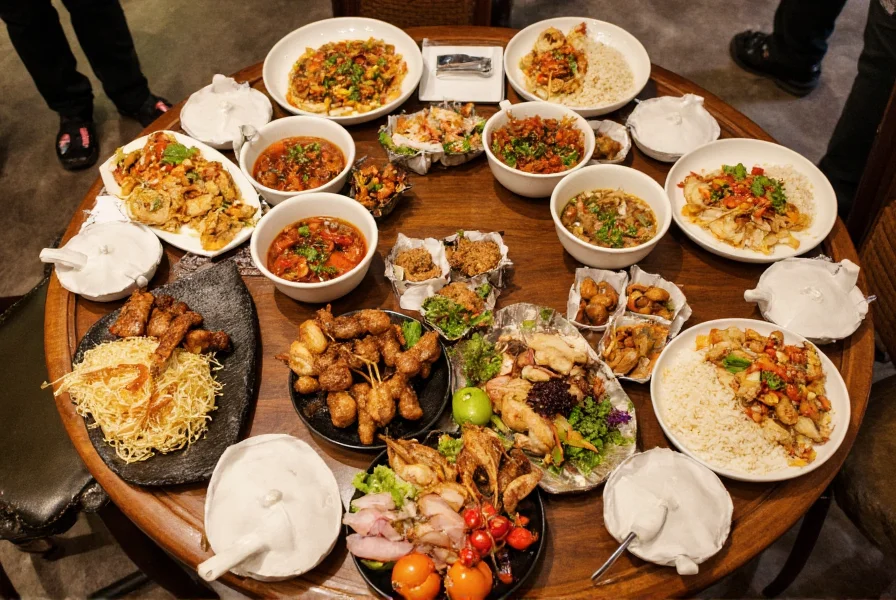When exploring Thai cuisine, understanding how peppers function in traditional cooking is essential for navigating menus effectively. Unlike Western cuisines that might feature bell peppers prominently, authentic Thai cooking relies on the tiny but mighty bird's eye chili (prik kee noo) as the primary pepper variety. These vibrant red or green chilies deliver intense heat that's integral to Thailand's culinary identity.
Understanding Thai Peppers in Culinary Context
The term “Thai pepper” in menu contexts almost always refers to prik kee noo (bird's eye chili), not a specific restaurant called “Thai Pepper.” These diminutive peppers pack significant heat—measuring between 50,000-100,000 Scoville units—making them substantially hotter than jalapeños (2,500-8,000 units) but milder than some habaneros. Thai cooks use them both fresh and dried, with fresh green chilies appearing in salads and curries, while dried red versions flavor many stir-fries and dipping sauces.
Authentic Thai restaurants typically don't categorize dishes by pepper type but indicate spice levels through standardized terminology. When examining a thai restaurant menu pepper explanation, look for these common indicators:
| Thai Term | English Translation | Spice Level | What to Expect |
|---|---|---|---|
| Mai pet | No spice | 0/10 | Child-friendly, minimal heat |
| Pet nit noi | A little spicy | 3/10 | Mild warmth, approachable for beginners |
| Pet | Spicy | 6/10 | Authentic heat level preferred by Thais |
| Pet mak mak | Very spicy | 9/10 | Intense heat for experienced eaters |
Common Thai Dishes Featuring Peppers
Understanding how to decipher thai menu spice indicators becomes crucial when ordering these classic pepper-forward dishes:
- Tom Yum Soup - The iconic hot and sour soup where bird's eye chilies provide the characteristic heat. Request "pet nit noi" if you're sensitive to spice.
- Pad Prik King - Stir-fried meat with green beans and an abundance of fresh chilies in a rich curry paste.
- Som Tum (Green Papaya Salad) - A Northeastern Thai specialty where chilies are pounded with other ingredients in a mortar and pestle.
- Yam Woon Sen - Glass noodle salad with a spicy lime-chili dressing that can be adjusted to preference.

Navigating Authentic Thai Menus
When learning how to order thai food with peppers authentically, remember that Thai cuisine balances heat with other elements. The spiciness serves to enhance rather than dominate the dish. Many Thai restaurants outside Thailand adjust spice levels for local palates, so don't be surprised if your "pet" dish seems milder than expected.
For those seeking authentic thai pepper dishes explained, look for these menu clues:
- Dishes containing "prik" in the name almost certainly include chilies
- "Nam prik" refers to chili-based dipping sauces
- "Gaeng" indicates curry, which traditionally contains chilies
- "Yam" signifies a spicy salad preparation
Regional Variations in Pepper Usage
Thailand's regional cuisines feature distinct approaches to thai bird's eye chili menu guide applications. Northern Thai cuisine tends to be milder with less emphasis on chilies, while Northeastern (Isaan) dishes like som tum deliver intense heat. Central Thai cooking balances spice with sweet and sour elements, and Southern Thai food often features the hottest preparations with generous chili usage.
When exploring how to navigate thai menu spiciness levels, consider that street food vendors typically serve spicier food than restaurant versions. If you're dining in Thailand or at an authentic establishment, don't be shy about specifying your preferred heat level—most places will accommodate requests for "mai pet" (no spice) or "pet nit noi" (a little spicy).

Practical Tips for Pepper Newcomers
For those unfamiliar with understanding thai spice levels on menus, here are practical recommendations:
- Start with "pet nit noi" (a little spicy) even if you consider yourself heat-tolerant—Thai spice perception differs from Western expectations
- Order coconut-based dishes like Massaman curry if you prefer milder flavors
- Request that chilies be served on the side for dishes like Pad Thai
- Have cooling accompaniments ready—Thai iced tea, coconut water, or sticky rice help mitigate heat
- Don't assume red color equals spiciness—many red ingredients in Thai cooking (like tomatoes) aren't spicy
Remember that in Thailand, spice level customization is standard practice. Don't hesitate to communicate your preferences—most authentic Thai restaurants expect and accommodate varying heat tolerances. The goal is enjoying the complex flavor profile, not enduring unnecessary discomfort.
Frequently Asked Questions
What does 'prik kee noo' mean on a Thai menu?
'Prik kee noo' (ผิกคี้นู้) translates to 'bird's eye chili' in Thai. This refers to the small, extremely spicy chilies fundamental to Thai cuisine. When you see dishes described with 'prik kee noo,' expect significant heat unless you specify otherwise.
How can I tell if a Thai dish will be spicy just by reading the menu?
Look for terms like 'pet' (spicy), 'nam prik' (chili dipping sauce), or 'prik' in dish names. Dishes featuring 'tom' (soup) or 'yam' (salad) are often spicy, while 'gaeng' (curry) dishes vary by type. When in doubt, ask staff to indicate spice levels for specific dishes.
Is there a difference between red and green Thai peppers on menus?
Both red and green Thai bird's eye chilies have similar heat levels, with green being slightly less mature. Red chilies often appear in cooked dishes while green are common in fresh preparations like salads. The color difference doesn't indicate significant spice variation.
Why do some Thai restaurants serve sugar with spicy dishes?
Sugar helps balance the heat from chilies. Many authentic Thai restaurants provide small bowls of sugar specifically for adjusting spice levels to your preference. A pinch added to your dish can significantly reduce perceived heat without altering the authentic flavor profile.
Can I request no peppers in Thai dishes without compromising authenticity?
Yes, authentic Thai restaurants expect spice level customization. Requesting 'mai pet' (no spice) is common practice. While some traditional dishes rely on chili heat for balance, skilled chefs can adjust recipes to maintain authentic flavor profiles without excessive heat.










 浙公网安备
33010002000092号
浙公网安备
33010002000092号 浙B2-20120091-4
浙B2-20120091-4